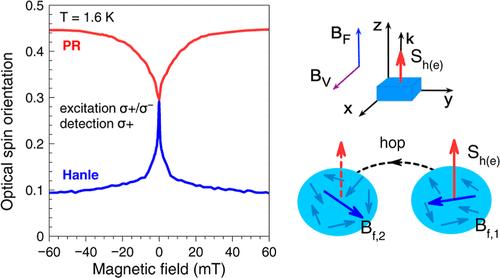当前位置:
X-MOL 学术
›
ACS Photonics
›
论文详情
Our official English website, www.x-mol.net, welcomes your feedback! (Note: you will need to create a separate account there.)
Optical Spin Orientation of Localized Electrons and Holes Interacting with Nuclei in a FA0.9Cs0.1PbI2.8Br0.2 Perovskite Crystal
ACS Photonics ( IF 6.5 ) Pub Date : 2024-06-14 , DOI: 10.1021/acsphotonics.4c00637 Dennis Kudlacik 1 , Nataliia E. Kopteva 1 , Mladen Kotur 1 , Dmitri R. Yakovlev 1 , Kirill V. Kavokin 2 , Carolin Harkort 1 , Marek Karzel 1 , Evgeny A. Zhukov 1 , Eiko Evers 1 , Vasilii V. Belykh 1 , Manfred Bayer 1
ACS Photonics ( IF 6.5 ) Pub Date : 2024-06-14 , DOI: 10.1021/acsphotonics.4c00637 Dennis Kudlacik 1 , Nataliia E. Kopteva 1 , Mladen Kotur 1 , Dmitri R. Yakovlev 1 , Kirill V. Kavokin 2 , Carolin Harkort 1 , Marek Karzel 1 , Evgeny A. Zhukov 1 , Eiko Evers 1 , Vasilii V. Belykh 1 , Manfred Bayer 1
Affiliation

|
Optical orientation of carrier spins by circularly polarized light is the basic concept and tool of spin physics in semiconductors. We study the optical orientation of electrons and holes in a crystal of the FA0.9Cs0.1PbI2.8Br0.2 lead halide perovskite by means of polarized photoluminescence, time-resolved differential reflectivity, and time-resolved Kerr rotation. At a cryogenic temperature of 1.6 K, the optical orientation degree measured for continuous-wave excitation reaches 6% for localized electrons and 2% for localized holes. Their contributions are distinguished from each other and from exciton optical orientation through the pronounced Hanle effect in transverse magnetic fields and the polarization recovery effect in longitudinal magnetic fields. The optical orientation degree is highly stable against detuning of the laser photon energy from the band gap by up to 0.25 eV, then showing a gradual decrease for detunings up to 0.9 eV. This evidences the inefficiency of spin relaxation mechanisms for free carriers during their energy relaxation. Spin relaxation for localized electrons and holes is provided by the hyperfine interaction with the nuclear spins. Dynamic polarization of nuclear spins is demonstrated by the Overhauser field reaching 4 mT acting on the electrons and −76 mT acting on the holes. This confirms the specifics of lead halide perovskite semiconductors, where the hole hyperfine interaction with the nuclei considerably exceeds that of the electron.
中文翻译:

FA0.9Cs0.1PbI2.8Br0.2 钙钛矿晶体中与原子核相互作用的局域电子和空穴的光学自旋取向
圆偏振光对载流子自旋的光学取向是半导体自旋物理的基本概念和工具。我们研究了 FA 0.9 Cs 0.1 PbI 2.8 Br 0.2 卤化铅钙钛矿晶体中电子和空穴的光学取向偏振光致发光、时间分辨微分反射率和时间分辨克尔旋转的方法。在1.6 K低温下,连续波激发测得的局域电子光学取向度达到6%,局域空穴光学取向度达到2%。它们的贡献彼此不同,并且通过横向磁场中显着的汉勒效应和纵向磁场中的极化恢复效应来区分激子光学取向。光学取向度对于激光光子能量从带隙失谐高达 0.25 eV 而言非常稳定,然后在失谐高达 0.9 eV 时表现出逐渐下降。这证明了自由载流子在能量弛豫期间自旋弛豫机制的低效率。局域电子和空穴的自旋弛豫是由与核自旋的超精细相互作用提供的。核自旋的动态极化通过作用于电子的奥弗豪瑟场达到 4 mT 和作用于空穴的 −76 mT 来证明。这证实了卤化铅钙钛矿半导体的特性,其中空穴与原子核的超精细相互作用大大超过了电子的相互作用。
更新日期:2024-06-18
中文翻译:

FA0.9Cs0.1PbI2.8Br0.2 钙钛矿晶体中与原子核相互作用的局域电子和空穴的光学自旋取向
圆偏振光对载流子自旋的光学取向是半导体自旋物理的基本概念和工具。我们研究了 FA 0.9 Cs 0.1 PbI 2.8 Br 0.2 卤化铅钙钛矿晶体中电子和空穴的光学取向偏振光致发光、时间分辨微分反射率和时间分辨克尔旋转的方法。在1.6 K低温下,连续波激发测得的局域电子光学取向度达到6%,局域空穴光学取向度达到2%。它们的贡献彼此不同,并且通过横向磁场中显着的汉勒效应和纵向磁场中的极化恢复效应来区分激子光学取向。光学取向度对于激光光子能量从带隙失谐高达 0.25 eV 而言非常稳定,然后在失谐高达 0.9 eV 时表现出逐渐下降。这证明了自由载流子在能量弛豫期间自旋弛豫机制的低效率。局域电子和空穴的自旋弛豫是由与核自旋的超精细相互作用提供的。核自旋的动态极化通过作用于电子的奥弗豪瑟场达到 4 mT 和作用于空穴的 −76 mT 来证明。这证实了卤化铅钙钛矿半导体的特性,其中空穴与原子核的超精细相互作用大大超过了电子的相互作用。






































 京公网安备 11010802027423号
京公网安备 11010802027423号